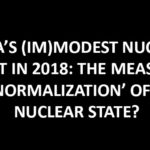Unless the government is transparent about details, it will be engulfed in yet another controversy
In December, the French company Électricité de France (EDF) submitted a “techno-commercial proposal” to the Indian government for the Jaitapur nuclear power project in Maharashtra. The idea of importing six nuclear European Pressurised Reactors (EPRs) was initiated by the United Progressive Alliance government more than a decade ago, but the project had made little progress due to concerns about the economics and safety of the EPRs, local opposition, and the collapse of the initial French corporate partner, Areva. Despite these problems, in the past few months, the Modi government has taken several high-level steps towards actuating the project.
In March 2018, EDF and the Nuclear Power Corporation of India (NPCIL) signed an “industrial way forward” agreement in the presence of Prime Minister Narendra Modi and French President Emmanuel Macron. Last month, after meeting the French Foreign Minister, Jean-Yves Le Drian, External Affairs Minister Sushma Swaraj announced that “both countries are working to start the Jaitapur project as soon as possible”. The urgency is inexplicable as it comes before the techno-commercial offer has been examined and as earlier questions about costs and safety remain unanswered. Moreover, with the Indian power sector facing surplus capacity and a crisis of non-performing assets (NPAs), a large investment in the Jaitapur project is particularly risky.
Delays and cost increases
It is clear that electricity from the Jaitapur project will be more expensive than many other sources of electricity, including solar and wind power. Using international estimates of capital costs for EPRs from the 2010-2012 period, and after adjusting for cost savings in India, we had shown in 2013 that first year tariffs from the project would be around ?15 per kilowatt-hour (“Repeating Enron in Jaitapur”, June 21, The Hindu). Even this figure must be revised upwards to account for the construction experience with EPRs over the past five years. Across the world, EPRs have experienced delays and cost increases. The first EPR entered commercial operation in December 2018 at the Taishan site in China, five years later than originally projected. Its final capital cost was estimated by industry sources to be “40% over the original estimate”. The story in Europe is more dramatic. The EPR at Flamanville in France, for example, went from an expected start date of 2012 to 2020, and a cost estimate of €3.3 billion to €10.9 billion. Two EPRs have been planned at Hinkley Point in the U.K. Even before construction began, the estimated cost has risen significantly to £20 billion (about ?1.75 lakh crore). The British National Audit Office assessed that the project “locked consumers into a risky and expensive project with uncertain strategic and economic benefits.”
While nuclear costs have been rising, other low-carbon sources of electricity, especially solar energy, have become cheaper. In 2010-11, tariffs for solar photovoltaic (PV) projects under the National Solar Mission were between ?10.95 and ?12.76 per unit. But several projects approved under Phase II of the mission have been connected to the grid in the last year with tariffs below ?5 per unit. In recent auctions for solar PV projects, winning tariff bids in the range of ?2 to ?2.50 per unit have become routine.
The high capital costs of the EPRs are of particular concern because power-generating capacity in India has grown faster than demand causing projects to run into financial difficulties. In March 2018, the parliamentary standing committee on energy listed 34 “stressed” projects, including NPAs and “those which have the potential to become NPAs”, with a cumulative outstanding debt of ?1.74 lakh crore. In this context, the government seems to be throwing caution to the winds by investing lakhs of crores in the Jaitapur project. Because the NPCIL’s debts would ultimately be underwritten by the Indian government, if the project encounters financial difficulties, the costs would fall on Indian taxpayers.
Safety problems
In addition to the high costs, safety problems with the reactor design and construction have emerged in several EPRs. The most serious of these pertained to the pressure vessel, which is the key barrier that prevents the spread of radioactive materials from the reactor. In April 2015, the French nuclear safety regulator, Autorité Sûreté Nucléaire, announced that some sections of the pressure vessel that the French Creusot Forge had supplied to the Flamanville and Taishan reactors had too much carbon in the steel. The Flamanville project was also found to have substandard welding in the reactor’s pipes. The EPR at Olkiluoto in Finland encountered problems with vibrations in the pipe that connects the primary coolant system with the pressuriser, which maintains the pressure of the water circulating in the reactor.
These safety concerns are exacerbated by India’s flawed nuclear liability law. If and when completed, Jaitapur “will be the largest nuclear power plant in the world”. In the event of an accident, the nuclear liability law would require the public sector NPCIL to compensate victims and pay for clean-up, while largely absolving EDF of responsibility.
The Indian law provides NPCIL with a limited opportunity to obtain compensation from EDF for the “supply of equipment… with… defects… or sub-standard services”. But the joint statement issued in March 2018 promises that the “enforcement of India’s rules” would be in accordance with the international Convention on Supplementary Compensation for nuclear damage, which severely limits the operator’s right of recourse. This raises the disturbing possibility that the NPCIL may have promised not to exercise its right to claim compensation from EDF as allowed by Indian law. In any event, there is a “moral hazard” here: since EDF can escape with limited or no consequences even after a severe accident, it has little material incentive to maintain the highest safety standards, particularly if the requirements of safety come into conflict with the imperative to lower costs. Such pressures might be accentuated by EDF’s poor financial state.
The Modi-Macron statement “emphasized the need for the project to generate cost-effective electricity”. It is hard to see how this is possible. To begin with, the government must answer several specific questions: how much will the entire project cost, who will be accountable for cost increases and delays, and what is the precise arrangement that the government has reached with France on liability? Unless it is transparent about these details, the Modi government may well find itself engulfed in yet another controversy involving overpriced French equipment.
Suvrat Raju and M.V. Ramana are physicists associated with the Coalition for Nuclear Disarmament and Peace, and currently based in Bengaluru and Vancouver, respectively. Views are personal
Source:- The Hindu


